Analyzing Leadership and Employee Performance at Workplace
VerifiedAdded on 2023/06/04
|13
|3942
|365
AI Summary
This essay analyzes the leadership and/or employee performance at workplace and compares it with the positive leadership and Psychological Capital literature. It includes a literature review and recommendations for improving workplace performance.
Contribute Materials
Your contribution can guide someone’s learning journey. Share your
documents today.
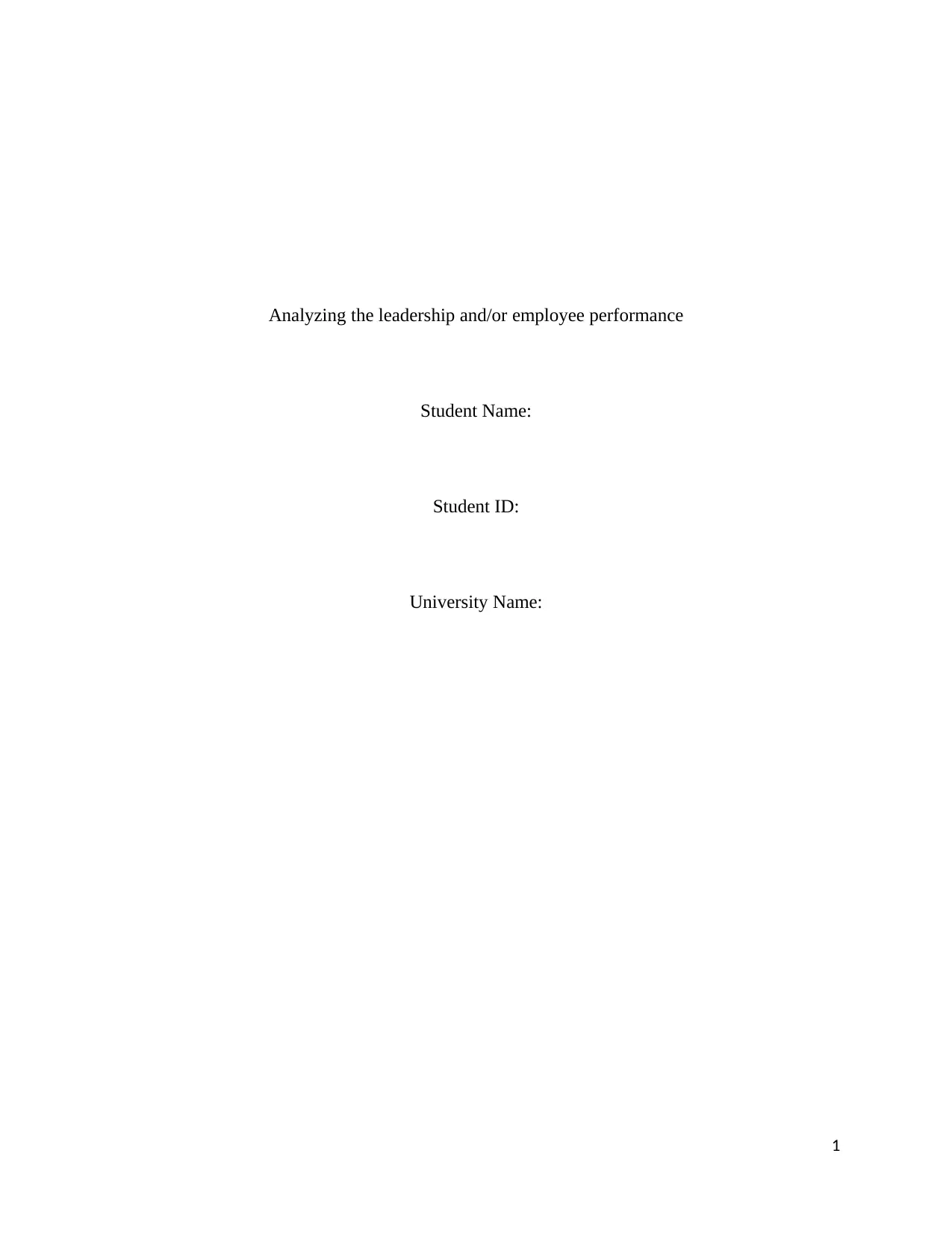
Analyzing the leadership and/or employee performance
Student Name:
Student ID:
University Name:
1
Student Name:
Student ID:
University Name:
1
Secure Best Marks with AI Grader
Need help grading? Try our AI Grader for instant feedback on your assignments.
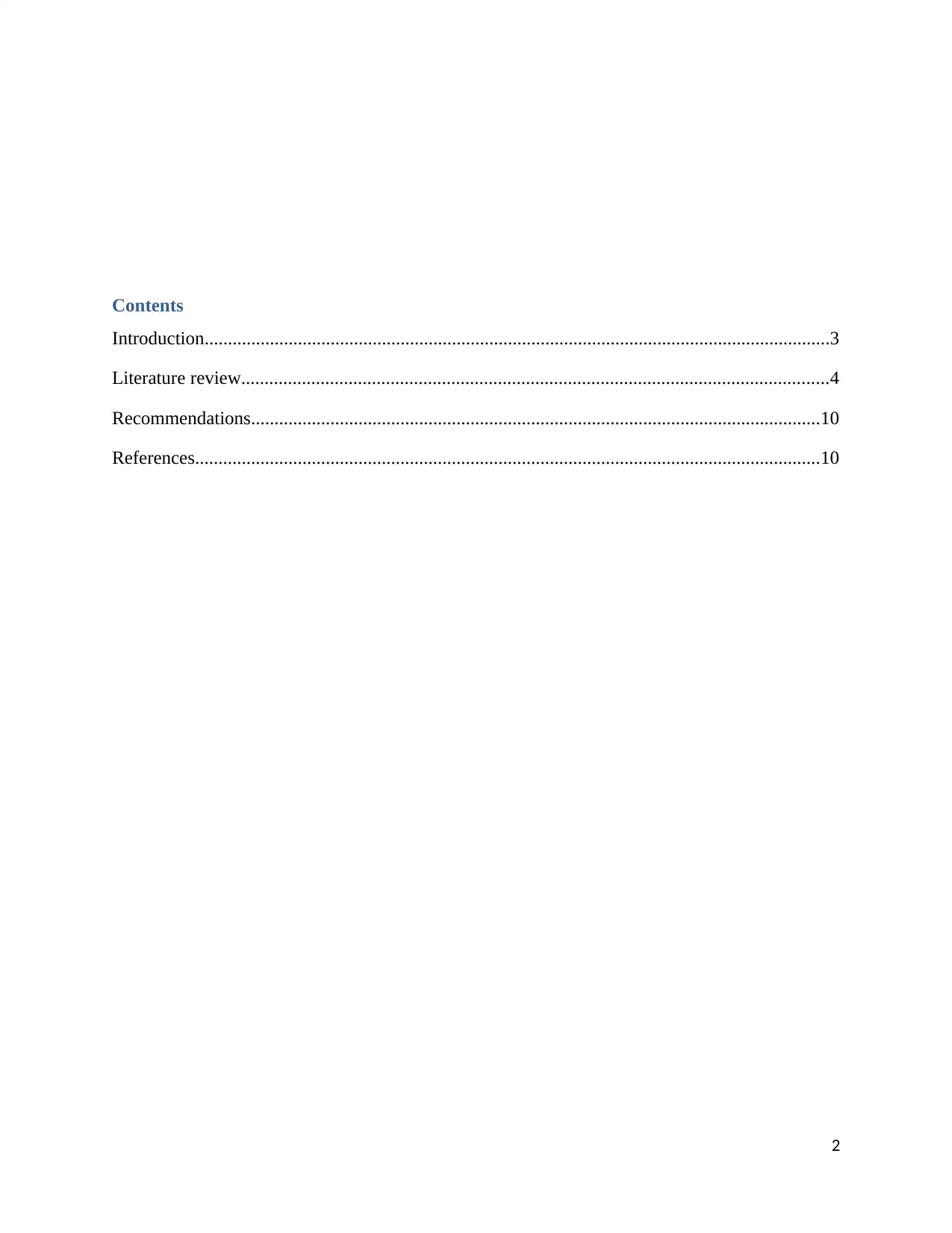
Contents
Introduction......................................................................................................................................3
Literature review..............................................................................................................................4
Recommendations..........................................................................................................................10
References......................................................................................................................................10
2
Introduction......................................................................................................................................3
Literature review..............................................................................................................................4
Recommendations..........................................................................................................................10
References......................................................................................................................................10
2
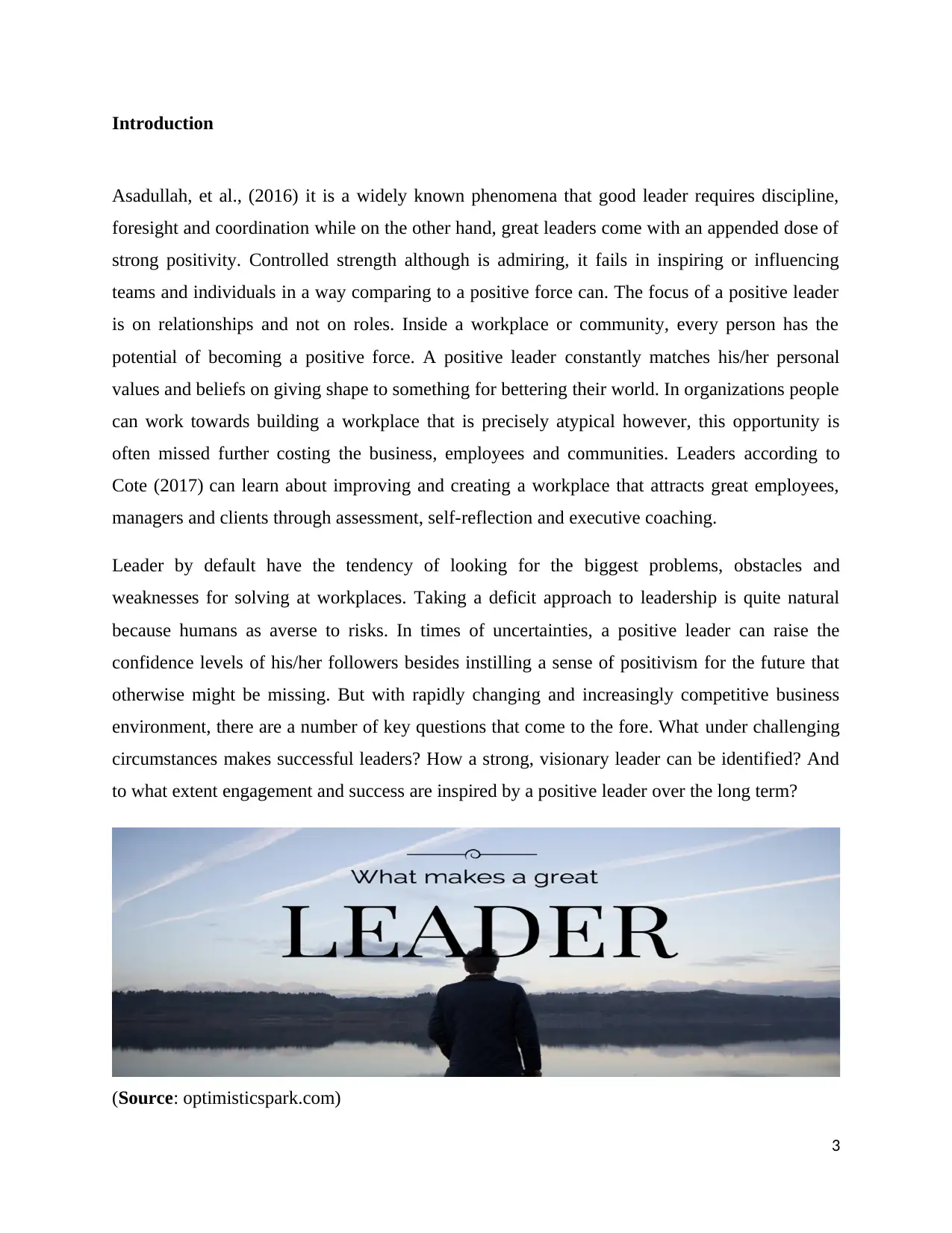
Introduction
Asadullah, et al., (2016) it is a widely known phenomena that good leader requires discipline,
foresight and coordination while on the other hand, great leaders come with an appended dose of
strong positivity. Controlled strength although is admiring, it fails in inspiring or influencing
teams and individuals in a way comparing to a positive force can. The focus of a positive leader
is on relationships and not on roles. Inside a workplace or community, every person has the
potential of becoming a positive force. A positive leader constantly matches his/her personal
values and beliefs on giving shape to something for bettering their world. In organizations people
can work towards building a workplace that is precisely atypical however, this opportunity is
often missed further costing the business, employees and communities. Leaders according to
Cote (2017) can learn about improving and creating a workplace that attracts great employees,
managers and clients through assessment, self-reflection and executive coaching.
Leader by default have the tendency of looking for the biggest problems, obstacles and
weaknesses for solving at workplaces. Taking a deficit approach to leadership is quite natural
because humans as averse to risks. In times of uncertainties, a positive leader can raise the
confidence levels of his/her followers besides instilling a sense of positivism for the future that
otherwise might be missing. But with rapidly changing and increasingly competitive business
environment, there are a number of key questions that come to the fore. What under challenging
circumstances makes successful leaders? How a strong, visionary leader can be identified? And
to what extent engagement and success are inspired by a positive leader over the long term?
(Source: optimisticspark.com)
3
Asadullah, et al., (2016) it is a widely known phenomena that good leader requires discipline,
foresight and coordination while on the other hand, great leaders come with an appended dose of
strong positivity. Controlled strength although is admiring, it fails in inspiring or influencing
teams and individuals in a way comparing to a positive force can. The focus of a positive leader
is on relationships and not on roles. Inside a workplace or community, every person has the
potential of becoming a positive force. A positive leader constantly matches his/her personal
values and beliefs on giving shape to something for bettering their world. In organizations people
can work towards building a workplace that is precisely atypical however, this opportunity is
often missed further costing the business, employees and communities. Leaders according to
Cote (2017) can learn about improving and creating a workplace that attracts great employees,
managers and clients through assessment, self-reflection and executive coaching.
Leader by default have the tendency of looking for the biggest problems, obstacles and
weaknesses for solving at workplaces. Taking a deficit approach to leadership is quite natural
because humans as averse to risks. In times of uncertainties, a positive leader can raise the
confidence levels of his/her followers besides instilling a sense of positivism for the future that
otherwise might be missing. But with rapidly changing and increasingly competitive business
environment, there are a number of key questions that come to the fore. What under challenging
circumstances makes successful leaders? How a strong, visionary leader can be identified? And
to what extent engagement and success are inspired by a positive leader over the long term?
(Source: optimisticspark.com)
3
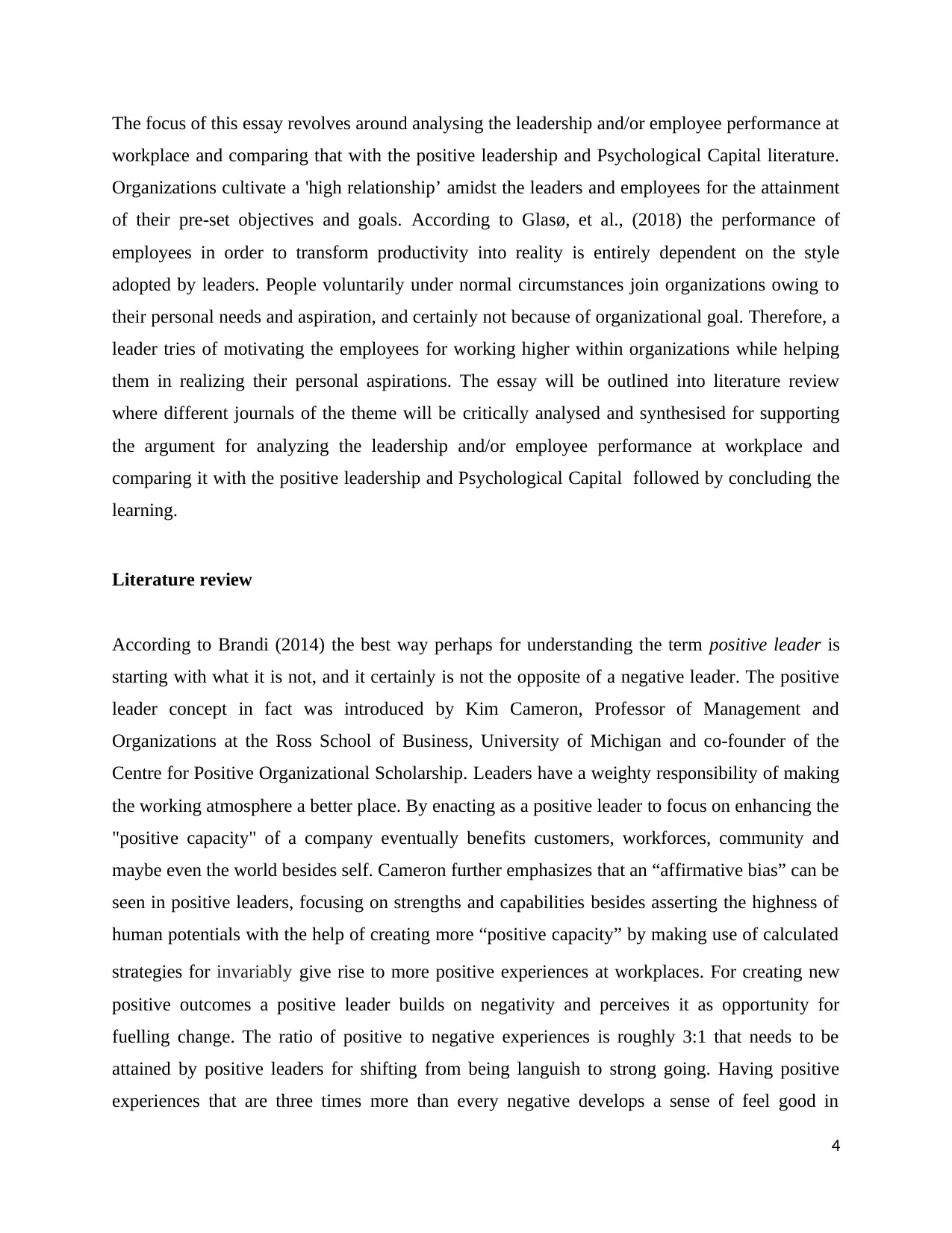
The focus of this essay revolves around analysing the leadership and/or employee performance at
workplace and comparing that with the positive leadership and Psychological Capital literature.
Organizations cultivate a 'high relationship’ amidst the leaders and employees for the attainment
of their pre-set objectives and goals. According to Glasø, et al., (2018) the performance of
employees in order to transform productivity into reality is entirely dependent on the style
adopted by leaders. People voluntarily under normal circumstances join organizations owing to
their personal needs and aspiration, and certainly not because of organizational goal. Therefore, a
leader tries of motivating the employees for working higher within organizations while helping
them in realizing their personal aspirations. The essay will be outlined into literature review
where different journals of the theme will be critically analysed and synthesised for supporting
the argument for analyzing the leadership and/or employee performance at workplace and
comparing it with the positive leadership and Psychological Capital followed by concluding the
learning.
Literature review
According to Brandi (2014) the best way perhaps for understanding the term positive leader is
starting with what it is not, and it certainly is not the opposite of a negative leader. The positive
leader concept in fact was introduced by Kim Cameron, Professor of Management and
Organizations at the Ross School of Business, University of Michigan and co-founder of the
Centre for Positive Organizational Scholarship. Leaders have a weighty responsibility of making
the working atmosphere a better place. By enacting as a positive leader to focus on enhancing the
"positive capacity" of a company eventually benefits customers, workforces, community and
maybe even the world besides self. Cameron further emphasizes that an “affirmative bias” can be
seen in positive leaders, focusing on strengths and capabilities besides asserting the highness of
human potentials with the help of creating more “positive capacity” by making use of calculated
strategies for invariably give rise to more positive experiences at workplaces. For creating new
positive outcomes a positive leader builds on negativity and perceives it as opportunity for
fuelling change. The ratio of positive to negative experiences is roughly 3:1 that needs to be
attained by positive leaders for shifting from being languish to strong going. Having positive
experiences that are three times more than every negative develops a sense of feel good in
4
workplace and comparing that with the positive leadership and Psychological Capital literature.
Organizations cultivate a 'high relationship’ amidst the leaders and employees for the attainment
of their pre-set objectives and goals. According to Glasø, et al., (2018) the performance of
employees in order to transform productivity into reality is entirely dependent on the style
adopted by leaders. People voluntarily under normal circumstances join organizations owing to
their personal needs and aspiration, and certainly not because of organizational goal. Therefore, a
leader tries of motivating the employees for working higher within organizations while helping
them in realizing their personal aspirations. The essay will be outlined into literature review
where different journals of the theme will be critically analysed and synthesised for supporting
the argument for analyzing the leadership and/or employee performance at workplace and
comparing it with the positive leadership and Psychological Capital followed by concluding the
learning.
Literature review
According to Brandi (2014) the best way perhaps for understanding the term positive leader is
starting with what it is not, and it certainly is not the opposite of a negative leader. The positive
leader concept in fact was introduced by Kim Cameron, Professor of Management and
Organizations at the Ross School of Business, University of Michigan and co-founder of the
Centre for Positive Organizational Scholarship. Leaders have a weighty responsibility of making
the working atmosphere a better place. By enacting as a positive leader to focus on enhancing the
"positive capacity" of a company eventually benefits customers, workforces, community and
maybe even the world besides self. Cameron further emphasizes that an “affirmative bias” can be
seen in positive leaders, focusing on strengths and capabilities besides asserting the highness of
human potentials with the help of creating more “positive capacity” by making use of calculated
strategies for invariably give rise to more positive experiences at workplaces. For creating new
positive outcomes a positive leader builds on negativity and perceives it as opportunity for
fuelling change. The ratio of positive to negative experiences is roughly 3:1 that needs to be
attained by positive leaders for shifting from being languish to strong going. Having positive
experiences that are three times more than every negative develops a sense of feel good in
4
Secure Best Marks with AI Grader
Need help grading? Try our AI Grader for instant feedback on your assignments.
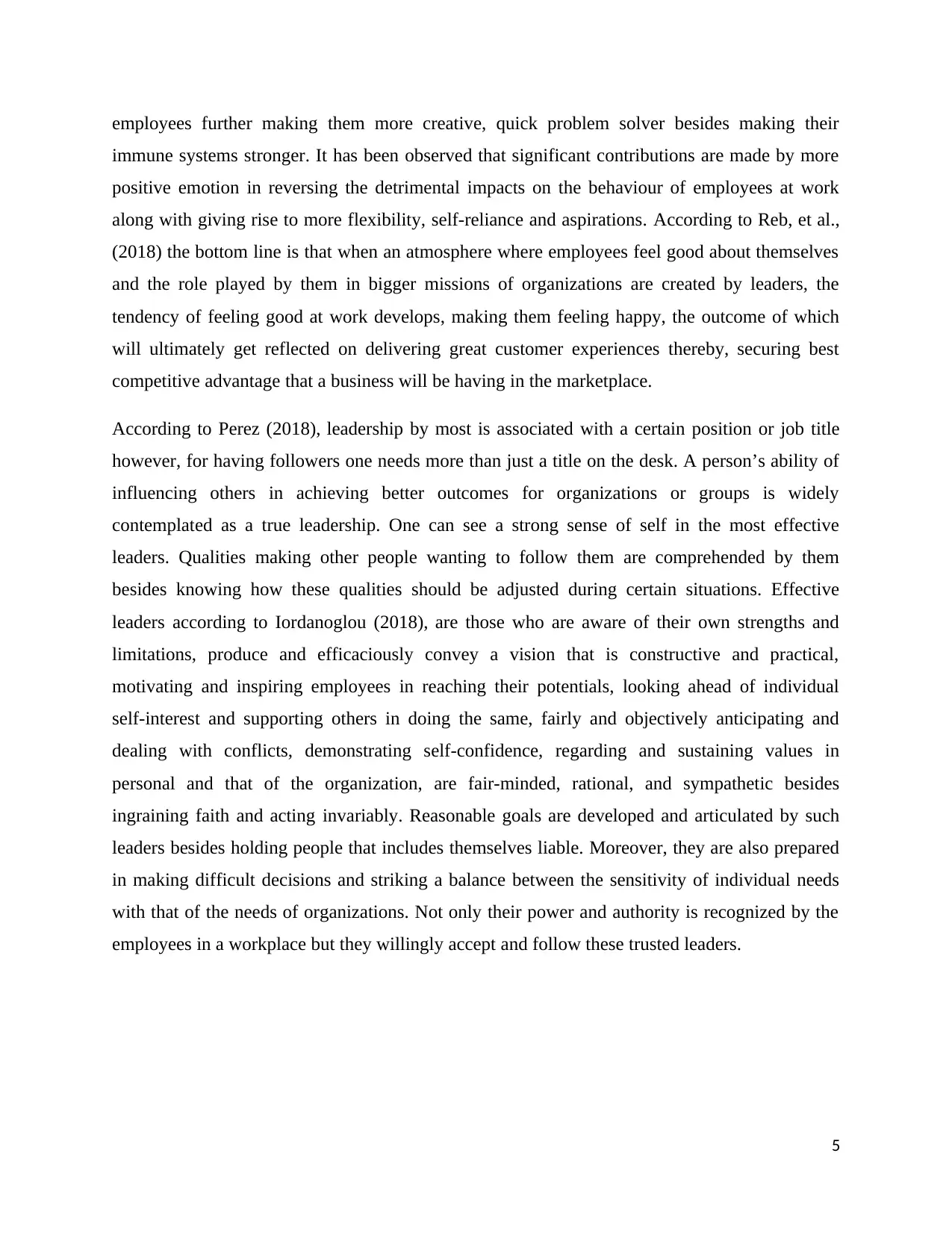
employees further making them more creative, quick problem solver besides making their
immune systems stronger. It has been observed that significant contributions are made by more
positive emotion in reversing the detrimental impacts on the behaviour of employees at work
along with giving rise to more flexibility, self-reliance and aspirations. According to Reb, et al.,
(2018) the bottom line is that when an atmosphere where employees feel good about themselves
and the role played by them in bigger missions of organizations are created by leaders, the
tendency of feeling good at work develops, making them feeling happy, the outcome of which
will ultimately get reflected on delivering great customer experiences thereby, securing best
competitive advantage that a business will be having in the marketplace.
According to Perez (2018), leadership by most is associated with a certain position or job title
however, for having followers one needs more than just a title on the desk. A person’s ability of
influencing others in achieving better outcomes for organizations or groups is widely
contemplated as a true leadership. One can see a strong sense of self in the most effective
leaders. Qualities making other people wanting to follow them are comprehended by them
besides knowing how these qualities should be adjusted during certain situations. Effective
leaders according to Iordanoglou (2018), are those who are aware of their own strengths and
limitations, produce and efficaciously convey a vision that is constructive and practical,
motivating and inspiring employees in reaching their potentials, looking ahead of individual
self-interest and supporting others in doing the same, fairly and objectively anticipating and
dealing with conflicts, demonstrating self-confidence, regarding and sustaining values in
personal and that of the organization, are fair-minded, rational, and sympathetic besides
ingraining faith and acting invariably. Reasonable goals are developed and articulated by such
leaders besides holding people that includes themselves liable. Moreover, they are also prepared
in making difficult decisions and striking a balance between the sensitivity of individual needs
with that of the needs of organizations. Not only their power and authority is recognized by the
employees in a workplace but they willingly accept and follow these trusted leaders.
5
immune systems stronger. It has been observed that significant contributions are made by more
positive emotion in reversing the detrimental impacts on the behaviour of employees at work
along with giving rise to more flexibility, self-reliance and aspirations. According to Reb, et al.,
(2018) the bottom line is that when an atmosphere where employees feel good about themselves
and the role played by them in bigger missions of organizations are created by leaders, the
tendency of feeling good at work develops, making them feeling happy, the outcome of which
will ultimately get reflected on delivering great customer experiences thereby, securing best
competitive advantage that a business will be having in the marketplace.
According to Perez (2018), leadership by most is associated with a certain position or job title
however, for having followers one needs more than just a title on the desk. A person’s ability of
influencing others in achieving better outcomes for organizations or groups is widely
contemplated as a true leadership. One can see a strong sense of self in the most effective
leaders. Qualities making other people wanting to follow them are comprehended by them
besides knowing how these qualities should be adjusted during certain situations. Effective
leaders according to Iordanoglou (2018), are those who are aware of their own strengths and
limitations, produce and efficaciously convey a vision that is constructive and practical,
motivating and inspiring employees in reaching their potentials, looking ahead of individual
self-interest and supporting others in doing the same, fairly and objectively anticipating and
dealing with conflicts, demonstrating self-confidence, regarding and sustaining values in
personal and that of the organization, are fair-minded, rational, and sympathetic besides
ingraining faith and acting invariably. Reasonable goals are developed and articulated by such
leaders besides holding people that includes themselves liable. Moreover, they are also prepared
in making difficult decisions and striking a balance between the sensitivity of individual needs
with that of the needs of organizations. Not only their power and authority is recognized by the
employees in a workplace but they willingly accept and follow these trusted leaders.
5
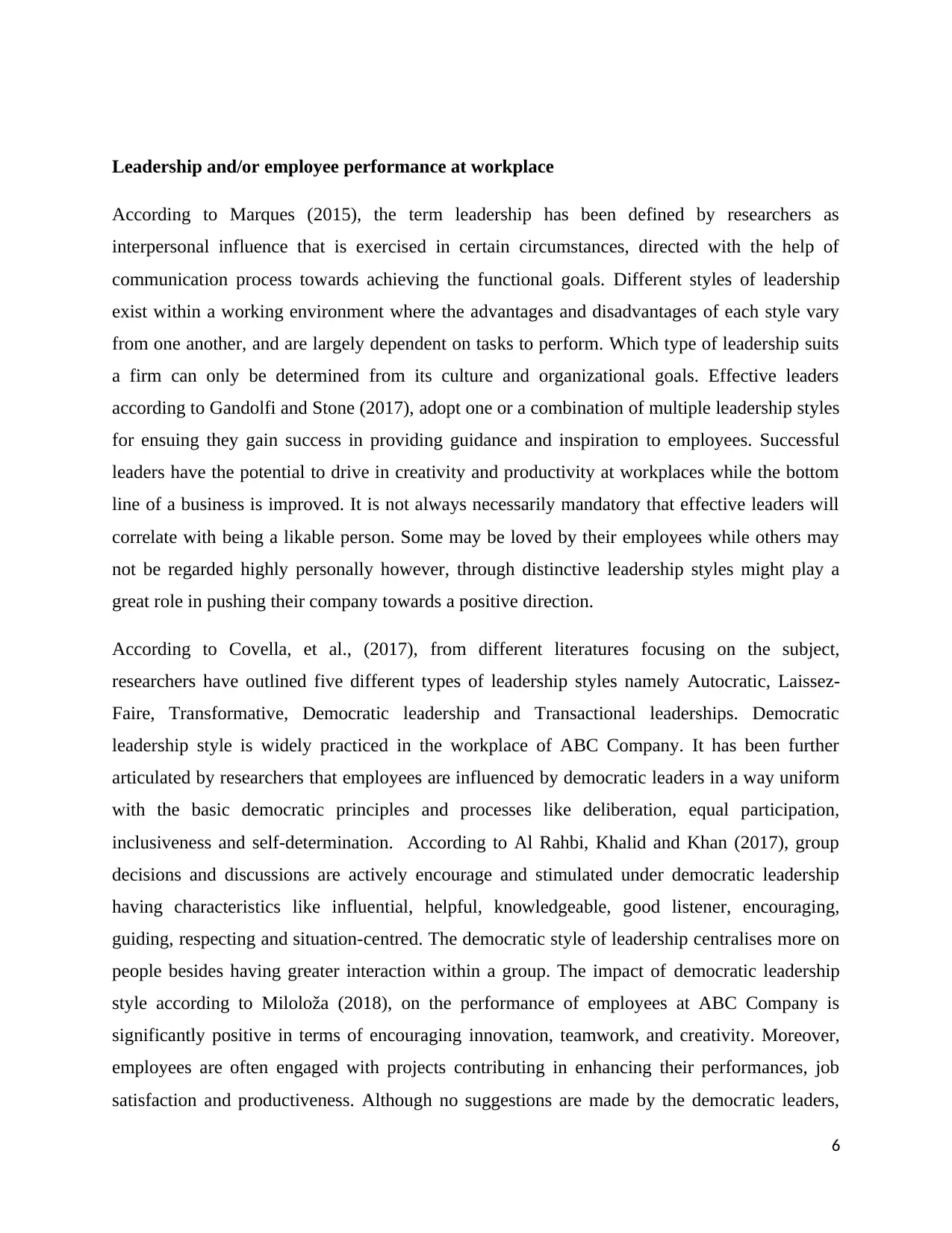
Leadership and/or employee performance at workplace
According to Marques (2015), the term leadership has been defined by researchers as
interpersonal influence that is exercised in certain circumstances, directed with the help of
communication process towards achieving the functional goals. Different styles of leadership
exist within a working environment where the advantages and disadvantages of each style vary
from one another, and are largely dependent on tasks to perform. Which type of leadership suits
a firm can only be determined from its culture and organizational goals. Effective leaders
according to Gandolfi and Stone (2017), adopt one or a combination of multiple leadership styles
for ensuing they gain success in providing guidance and inspiration to employees. Successful
leaders have the potential to drive in creativity and productivity at workplaces while the bottom
line of a business is improved. It is not always necessarily mandatory that effective leaders will
correlate with being a likable person. Some may be loved by their employees while others may
not be regarded highly personally however, through distinctive leadership styles might play a
great role in pushing their company towards a positive direction.
According to Covella, et al., (2017), from different literatures focusing on the subject,
researchers have outlined five different types of leadership styles namely Autocratic, Laissez-
Faire, Transformative, Democratic leadership and Transactional leaderships. Democratic
leadership style is widely practiced in the workplace of ABC Company. It has been further
articulated by researchers that employees are influenced by democratic leaders in a way uniform
with the basic democratic principles and processes like deliberation, equal participation,
inclusiveness and self-determination. According to Al Rahbi, Khalid and Khan (2017), group
decisions and discussions are actively encourage and stimulated under democratic leadership
having characteristics like influential, helpful, knowledgeable, good listener, encouraging,
guiding, respecting and situation-centred. The democratic style of leadership centralises more on
people besides having greater interaction within a group. The impact of democratic leadership
style according to Miloloža (2018), on the performance of employees at ABC Company is
significantly positive in terms of encouraging innovation, teamwork, and creativity. Moreover,
employees are often engaged with projects contributing in enhancing their performances, job
satisfaction and productiveness. Although no suggestions are made by the democratic leaders,
6
According to Marques (2015), the term leadership has been defined by researchers as
interpersonal influence that is exercised in certain circumstances, directed with the help of
communication process towards achieving the functional goals. Different styles of leadership
exist within a working environment where the advantages and disadvantages of each style vary
from one another, and are largely dependent on tasks to perform. Which type of leadership suits
a firm can only be determined from its culture and organizational goals. Effective leaders
according to Gandolfi and Stone (2017), adopt one or a combination of multiple leadership styles
for ensuing they gain success in providing guidance and inspiration to employees. Successful
leaders have the potential to drive in creativity and productivity at workplaces while the bottom
line of a business is improved. It is not always necessarily mandatory that effective leaders will
correlate with being a likable person. Some may be loved by their employees while others may
not be regarded highly personally however, through distinctive leadership styles might play a
great role in pushing their company towards a positive direction.
According to Covella, et al., (2017), from different literatures focusing on the subject,
researchers have outlined five different types of leadership styles namely Autocratic, Laissez-
Faire, Transformative, Democratic leadership and Transactional leaderships. Democratic
leadership style is widely practiced in the workplace of ABC Company. It has been further
articulated by researchers that employees are influenced by democratic leaders in a way uniform
with the basic democratic principles and processes like deliberation, equal participation,
inclusiveness and self-determination. According to Al Rahbi, Khalid and Khan (2017), group
decisions and discussions are actively encourage and stimulated under democratic leadership
having characteristics like influential, helpful, knowledgeable, good listener, encouraging,
guiding, respecting and situation-centred. The democratic style of leadership centralises more on
people besides having greater interaction within a group. The impact of democratic leadership
style according to Miloloža (2018), on the performance of employees at ABC Company is
significantly positive in terms of encouraging innovation, teamwork, and creativity. Moreover,
employees are often engaged with projects contributing in enhancing their performances, job
satisfaction and productiveness. Although no suggestions are made by the democratic leaders,
6
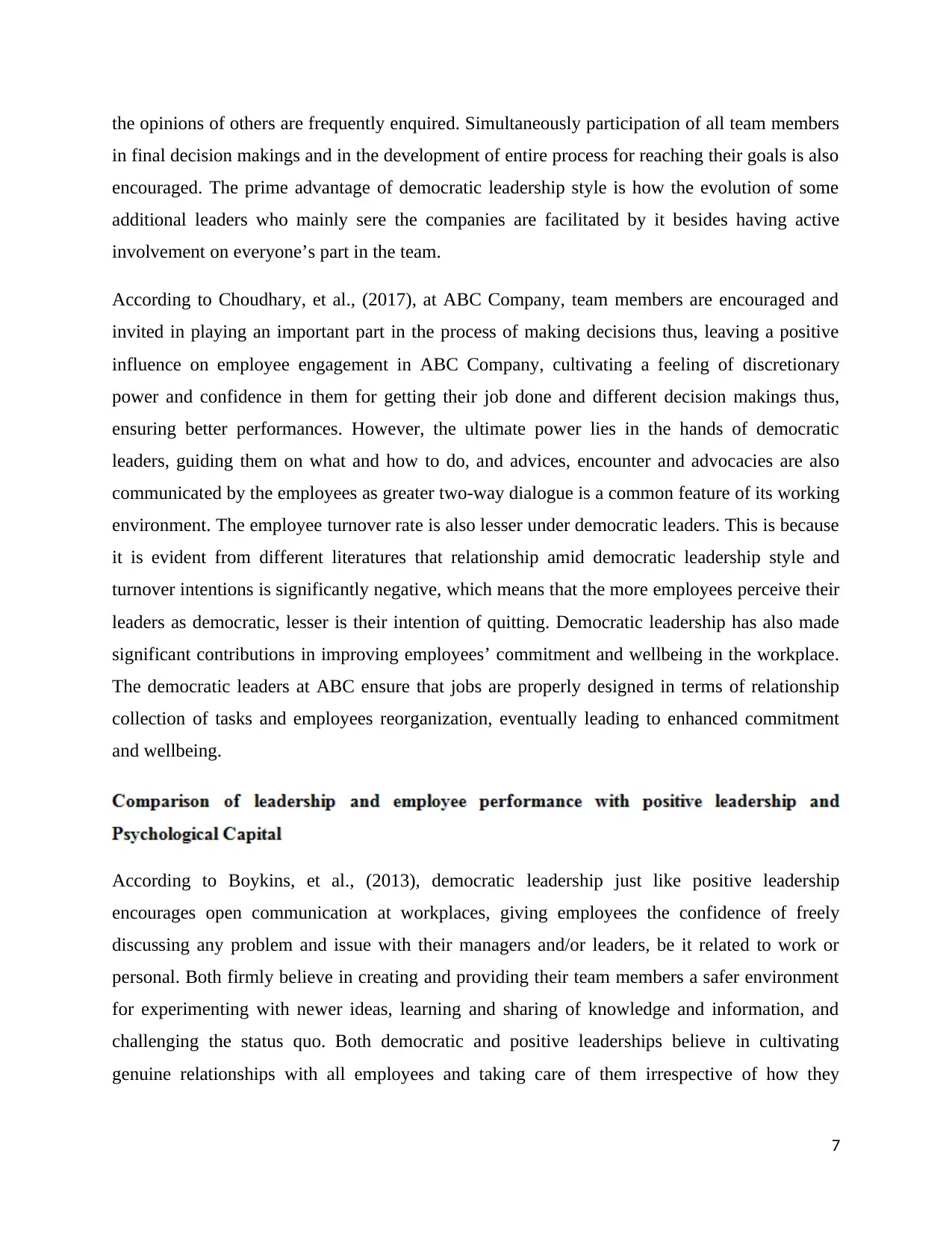
the opinions of others are frequently enquired. Simultaneously participation of all team members
in final decision makings and in the development of entire process for reaching their goals is also
encouraged. The prime advantage of democratic leadership style is how the evolution of some
additional leaders who mainly sere the companies are facilitated by it besides having active
involvement on everyone’s part in the team.
According to Choudhary, et al., (2017), at ABC Company, team members are encouraged and
invited in playing an important part in the process of making decisions thus, leaving a positive
influence on employee engagement in ABC Company, cultivating a feeling of discretionary
power and confidence in them for getting their job done and different decision makings thus,
ensuring better performances. However, the ultimate power lies in the hands of democratic
leaders, guiding them on what and how to do, and advices, encounter and advocacies are also
communicated by the employees as greater two-way dialogue is a common feature of its working
environment. The employee turnover rate is also lesser under democratic leaders. This is because
it is evident from different literatures that relationship amid democratic leadership style and
turnover intentions is significantly negative, which means that the more employees perceive their
leaders as democratic, lesser is their intention of quitting. Democratic leadership has also made
significant contributions in improving employees’ commitment and wellbeing in the workplace.
The democratic leaders at ABC ensure that jobs are properly designed in terms of relationship
collection of tasks and employees reorganization, eventually leading to enhanced commitment
and wellbeing.
According to Boykins, et al., (2013), democratic leadership just like positive leadership
encourages open communication at workplaces, giving employees the confidence of freely
discussing any problem and issue with their managers and/or leaders, be it related to work or
personal. Both firmly believe in creating and providing their team members a safer environment
for experimenting with newer ideas, learning and sharing of knowledge and information, and
challenging the status quo. Both democratic and positive leaderships believe in cultivating
genuine relationships with all employees and taking care of them irrespective of how they
7
in final decision makings and in the development of entire process for reaching their goals is also
encouraged. The prime advantage of democratic leadership style is how the evolution of some
additional leaders who mainly sere the companies are facilitated by it besides having active
involvement on everyone’s part in the team.
According to Choudhary, et al., (2017), at ABC Company, team members are encouraged and
invited in playing an important part in the process of making decisions thus, leaving a positive
influence on employee engagement in ABC Company, cultivating a feeling of discretionary
power and confidence in them for getting their job done and different decision makings thus,
ensuring better performances. However, the ultimate power lies in the hands of democratic
leaders, guiding them on what and how to do, and advices, encounter and advocacies are also
communicated by the employees as greater two-way dialogue is a common feature of its working
environment. The employee turnover rate is also lesser under democratic leaders. This is because
it is evident from different literatures that relationship amid democratic leadership style and
turnover intentions is significantly negative, which means that the more employees perceive their
leaders as democratic, lesser is their intention of quitting. Democratic leadership has also made
significant contributions in improving employees’ commitment and wellbeing in the workplace.
The democratic leaders at ABC ensure that jobs are properly designed in terms of relationship
collection of tasks and employees reorganization, eventually leading to enhanced commitment
and wellbeing.
According to Boykins, et al., (2013), democratic leadership just like positive leadership
encourages open communication at workplaces, giving employees the confidence of freely
discussing any problem and issue with their managers and/or leaders, be it related to work or
personal. Both firmly believe in creating and providing their team members a safer environment
for experimenting with newer ideas, learning and sharing of knowledge and information, and
challenging the status quo. Both democratic and positive leaderships believe in cultivating
genuine relationships with all employees and taking care of them irrespective of how they
7
Paraphrase This Document
Need a fresh take? Get an instant paraphrase of this document with our AI Paraphraser
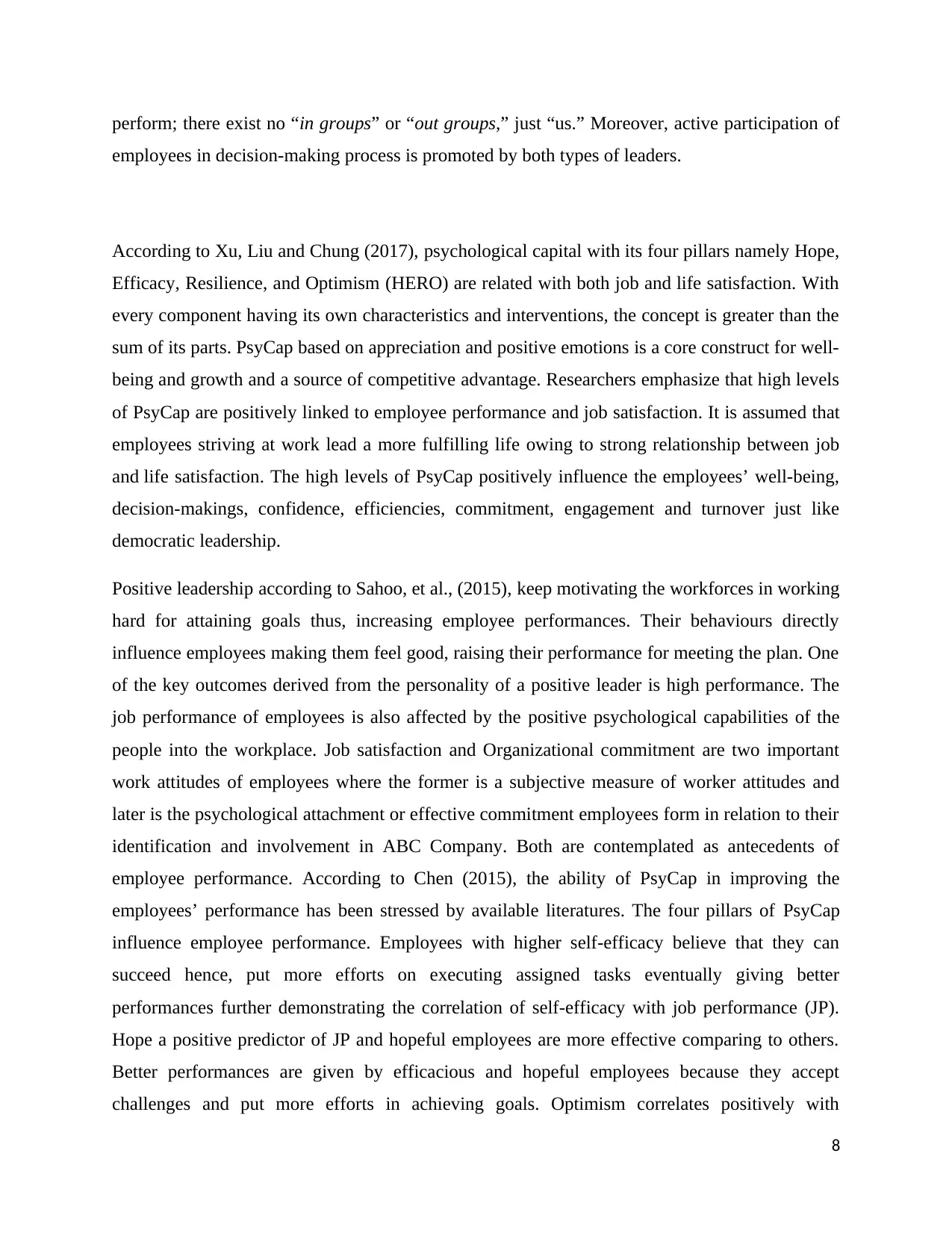
perform; there exist no “in groups” or “out groups,” just “us.” Moreover, active participation of
employees in decision-making process is promoted by both types of leaders.
According to Xu, Liu and Chung (2017), psychological capital with its four pillars namely Hope,
Efficacy, Resilience, and Optimism (HERO) are related with both job and life satisfaction. With
every component having its own characteristics and interventions, the concept is greater than the
sum of its parts. PsyCap based on appreciation and positive emotions is a core construct for well-
being and growth and a source of competitive advantage. Researchers emphasize that high levels
of PsyCap are positively linked to employee performance and job satisfaction. It is assumed that
employees striving at work lead a more fulfilling life owing to strong relationship between job
and life satisfaction. The high levels of PsyCap positively influence the employees’ well-being,
decision-makings, confidence, efficiencies, commitment, engagement and turnover just like
democratic leadership.
Positive leadership according to Sahoo, et al., (2015), keep motivating the workforces in working
hard for attaining goals thus, increasing employee performances. Their behaviours directly
influence employees making them feel good, raising their performance for meeting the plan. One
of the key outcomes derived from the personality of a positive leader is high performance. The
job performance of employees is also affected by the positive psychological capabilities of the
people into the workplace. Job satisfaction and Organizational commitment are two important
work attitudes of employees where the former is a subjective measure of worker attitudes and
later is the psychological attachment or effective commitment employees form in relation to their
identification and involvement in ABC Company. Both are contemplated as antecedents of
employee performance. According to Chen (2015), the ability of PsyCap in improving the
employees’ performance has been stressed by available literatures. The four pillars of PsyCap
influence employee performance. Employees with higher self-efficacy believe that they can
succeed hence, put more efforts on executing assigned tasks eventually giving better
performances further demonstrating the correlation of self-efficacy with job performance (JP).
Hope a positive predictor of JP and hopeful employees are more effective comparing to others.
Better performances are given by efficacious and hopeful employees because they accept
challenges and put more efforts in achieving goals. Optimism correlates positively with
8
employees in decision-making process is promoted by both types of leaders.
According to Xu, Liu and Chung (2017), psychological capital with its four pillars namely Hope,
Efficacy, Resilience, and Optimism (HERO) are related with both job and life satisfaction. With
every component having its own characteristics and interventions, the concept is greater than the
sum of its parts. PsyCap based on appreciation and positive emotions is a core construct for well-
being and growth and a source of competitive advantage. Researchers emphasize that high levels
of PsyCap are positively linked to employee performance and job satisfaction. It is assumed that
employees striving at work lead a more fulfilling life owing to strong relationship between job
and life satisfaction. The high levels of PsyCap positively influence the employees’ well-being,
decision-makings, confidence, efficiencies, commitment, engagement and turnover just like
democratic leadership.
Positive leadership according to Sahoo, et al., (2015), keep motivating the workforces in working
hard for attaining goals thus, increasing employee performances. Their behaviours directly
influence employees making them feel good, raising their performance for meeting the plan. One
of the key outcomes derived from the personality of a positive leader is high performance. The
job performance of employees is also affected by the positive psychological capabilities of the
people into the workplace. Job satisfaction and Organizational commitment are two important
work attitudes of employees where the former is a subjective measure of worker attitudes and
later is the psychological attachment or effective commitment employees form in relation to their
identification and involvement in ABC Company. Both are contemplated as antecedents of
employee performance. According to Chen (2015), the ability of PsyCap in improving the
employees’ performance has been stressed by available literatures. The four pillars of PsyCap
influence employee performance. Employees with higher self-efficacy believe that they can
succeed hence, put more efforts on executing assigned tasks eventually giving better
performances further demonstrating the correlation of self-efficacy with job performance (JP).
Hope a positive predictor of JP and hopeful employees are more effective comparing to others.
Better performances are given by efficacious and hopeful employees because they accept
challenges and put more efforts in achieving goals. Optimism correlates positively with
8
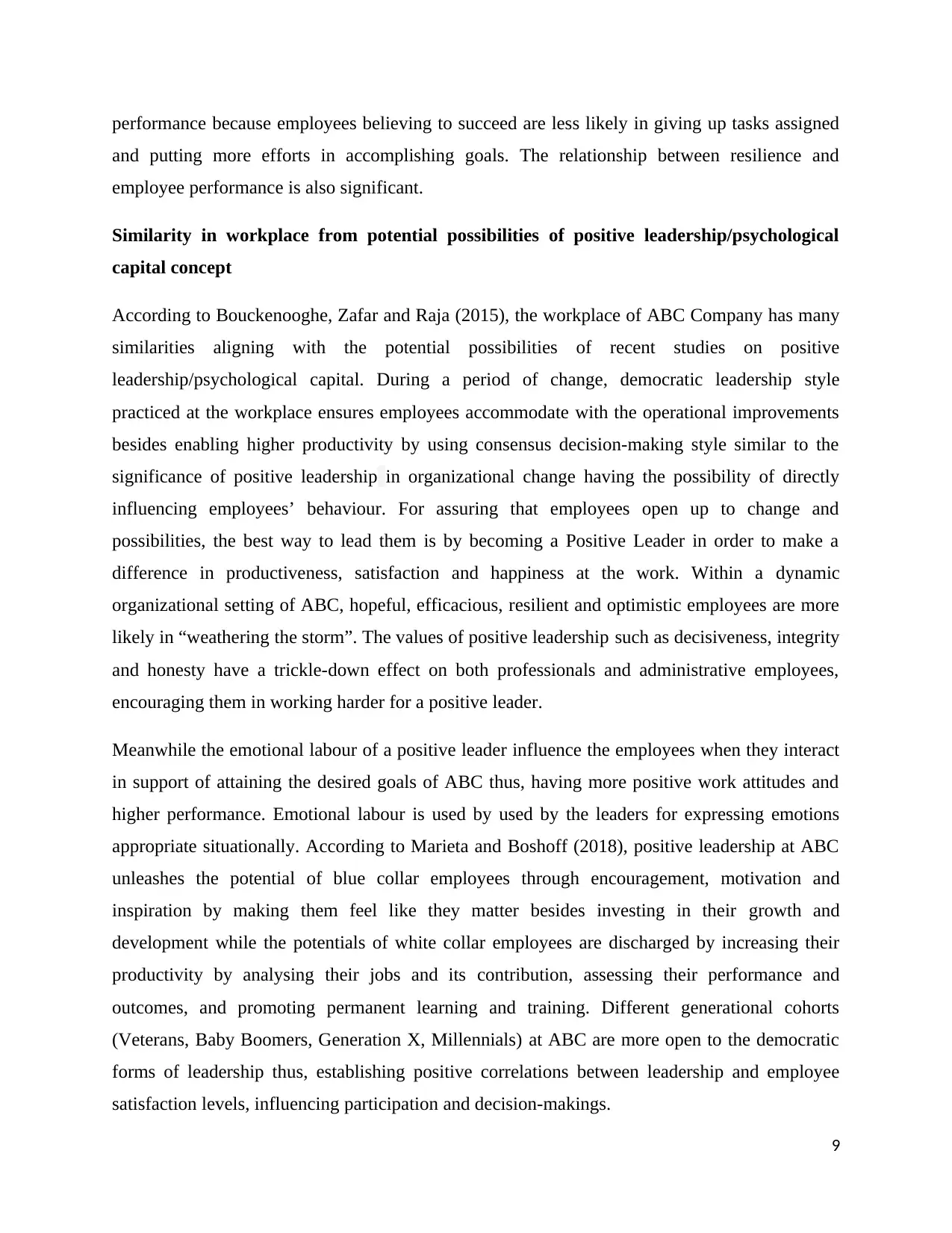
performance because employees believing to succeed are less likely in giving up tasks assigned
and putting more efforts in accomplishing goals. The relationship between resilience and
employee performance is also significant.
Similarity in workplace from potential possibilities of positive leadership/psychological
capital concept
According to Bouckenooghe, Zafar and Raja (2015), the workplace of ABC Company has many
similarities aligning with the potential possibilities of recent studies on positive
leadership/psychological capital. During a period of change, democratic leadership style
practiced at the workplace ensures employees accommodate with the operational improvements
besides enabling higher productivity by using consensus decision-making style similar to the
significance of positive leadership in organizational change having the possibility of directly
influencing employees’ behaviour. For assuring that employees open up to change and
possibilities, the best way to lead them is by becoming a Positive Leader in order to make a
difference in productiveness, satisfaction and happiness at the work. Within a dynamic
organizational setting of ABC, hopeful, efficacious, resilient and optimistic employees are more
likely in “weathering the storm”. The values of positive leadership such as decisiveness, integrity
and honesty have a trickle-down effect on both professionals and administrative employees,
encouraging them in working harder for a positive leader.
Meanwhile the emotional labour of a positive leader influence the employees when they interact
in support of attaining the desired goals of ABC thus, having more positive work attitudes and
higher performance. Emotional labour is used by used by the leaders for expressing emotions
appropriate situationally. According to Marieta and Boshoff (2018), positive leadership at ABC
unleashes the potential of blue collar employees through encouragement, motivation and
inspiration by making them feel like they matter besides investing in their growth and
development while the potentials of white collar employees are discharged by increasing their
productivity by analysing their jobs and its contribution, assessing their performance and
outcomes, and promoting permanent learning and training. Different generational cohorts
(Veterans, Baby Boomers, Generation X, Millennials) at ABC are more open to the democratic
forms of leadership thus, establishing positive correlations between leadership and employee
satisfaction levels, influencing participation and decision-makings.
9
and putting more efforts in accomplishing goals. The relationship between resilience and
employee performance is also significant.
Similarity in workplace from potential possibilities of positive leadership/psychological
capital concept
According to Bouckenooghe, Zafar and Raja (2015), the workplace of ABC Company has many
similarities aligning with the potential possibilities of recent studies on positive
leadership/psychological capital. During a period of change, democratic leadership style
practiced at the workplace ensures employees accommodate with the operational improvements
besides enabling higher productivity by using consensus decision-making style similar to the
significance of positive leadership in organizational change having the possibility of directly
influencing employees’ behaviour. For assuring that employees open up to change and
possibilities, the best way to lead them is by becoming a Positive Leader in order to make a
difference in productiveness, satisfaction and happiness at the work. Within a dynamic
organizational setting of ABC, hopeful, efficacious, resilient and optimistic employees are more
likely in “weathering the storm”. The values of positive leadership such as decisiveness, integrity
and honesty have a trickle-down effect on both professionals and administrative employees,
encouraging them in working harder for a positive leader.
Meanwhile the emotional labour of a positive leader influence the employees when they interact
in support of attaining the desired goals of ABC thus, having more positive work attitudes and
higher performance. Emotional labour is used by used by the leaders for expressing emotions
appropriate situationally. According to Marieta and Boshoff (2018), positive leadership at ABC
unleashes the potential of blue collar employees through encouragement, motivation and
inspiration by making them feel like they matter besides investing in their growth and
development while the potentials of white collar employees are discharged by increasing their
productivity by analysing their jobs and its contribution, assessing their performance and
outcomes, and promoting permanent learning and training. Different generational cohorts
(Veterans, Baby Boomers, Generation X, Millennials) at ABC are more open to the democratic
forms of leadership thus, establishing positive correlations between leadership and employee
satisfaction levels, influencing participation and decision-makings.
9
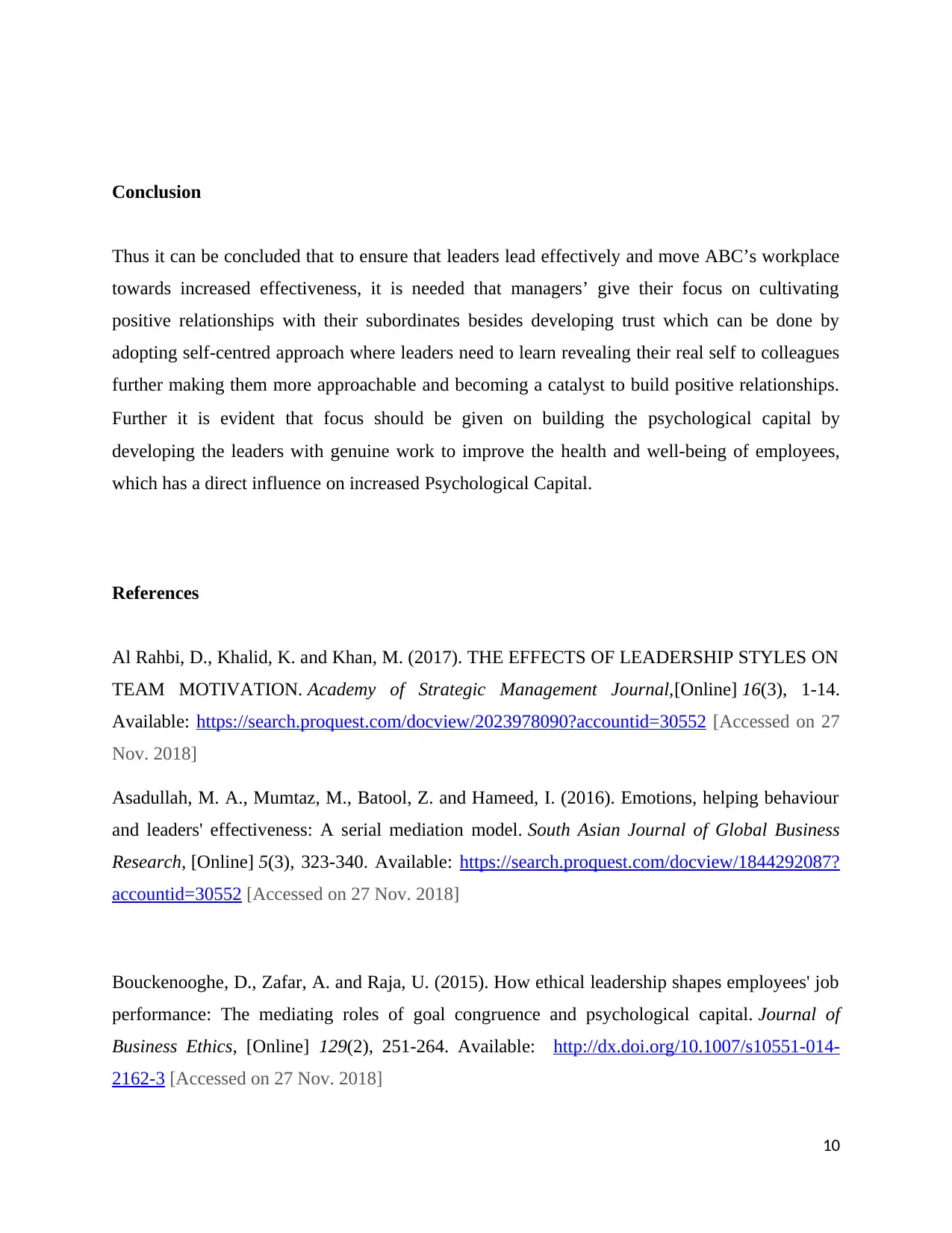
Conclusion
Thus it can be concluded that to ensure that leaders lead effectively and move ABC’s workplace
towards increased effectiveness, it is needed that managers’ give their focus on cultivating
positive relationships with their subordinates besides developing trust which can be done by
adopting self-centred approach where leaders need to learn revealing their real self to colleagues
further making them more approachable and becoming a catalyst to build positive relationships.
Further it is evident that focus should be given on building the psychological capital by
developing the leaders with genuine work to improve the health and well-being of employees,
which has a direct influence on increased Psychological Capital.
References
Al Rahbi, D., Khalid, K. and Khan, M. (2017). THE EFFECTS OF LEADERSHIP STYLES ON
TEAM MOTIVATION. Academy of Strategic Management Journal,[Online] 16(3), 1-14.
Available: https://search.proquest.com/docview/2023978090?accountid=30552 [Accessed on 27
Nov. 2018]
Asadullah, M. A., Mumtaz, M., Batool, Z. and Hameed, I. (2016). Emotions, helping behaviour
and leaders' effectiveness: A serial mediation model. South Asian Journal of Global Business
Research, [Online] 5(3), 323-340. Available: https://search.proquest.com/docview/1844292087?
accountid=30552 [Accessed on 27 Nov. 2018]
Bouckenooghe, D., Zafar, A. and Raja, U. (2015). How ethical leadership shapes employees' job
performance: The mediating roles of goal congruence and psychological capital. Journal of
Business Ethics, [Online] 129(2), 251-264. Available: http://dx.doi.org/10.1007/s10551-014-
2162-3 [Accessed on 27 Nov. 2018]
10
Thus it can be concluded that to ensure that leaders lead effectively and move ABC’s workplace
towards increased effectiveness, it is needed that managers’ give their focus on cultivating
positive relationships with their subordinates besides developing trust which can be done by
adopting self-centred approach where leaders need to learn revealing their real self to colleagues
further making them more approachable and becoming a catalyst to build positive relationships.
Further it is evident that focus should be given on building the psychological capital by
developing the leaders with genuine work to improve the health and well-being of employees,
which has a direct influence on increased Psychological Capital.
References
Al Rahbi, D., Khalid, K. and Khan, M. (2017). THE EFFECTS OF LEADERSHIP STYLES ON
TEAM MOTIVATION. Academy of Strategic Management Journal,[Online] 16(3), 1-14.
Available: https://search.proquest.com/docview/2023978090?accountid=30552 [Accessed on 27
Nov. 2018]
Asadullah, M. A., Mumtaz, M., Batool, Z. and Hameed, I. (2016). Emotions, helping behaviour
and leaders' effectiveness: A serial mediation model. South Asian Journal of Global Business
Research, [Online] 5(3), 323-340. Available: https://search.proquest.com/docview/1844292087?
accountid=30552 [Accessed on 27 Nov. 2018]
Bouckenooghe, D., Zafar, A. and Raja, U. (2015). How ethical leadership shapes employees' job
performance: The mediating roles of goal congruence and psychological capital. Journal of
Business Ethics, [Online] 129(2), 251-264. Available: http://dx.doi.org/10.1007/s10551-014-
2162-3 [Accessed on 27 Nov. 2018]
10
Secure Best Marks with AI Grader
Need help grading? Try our AI Grader for instant feedback on your assignments.
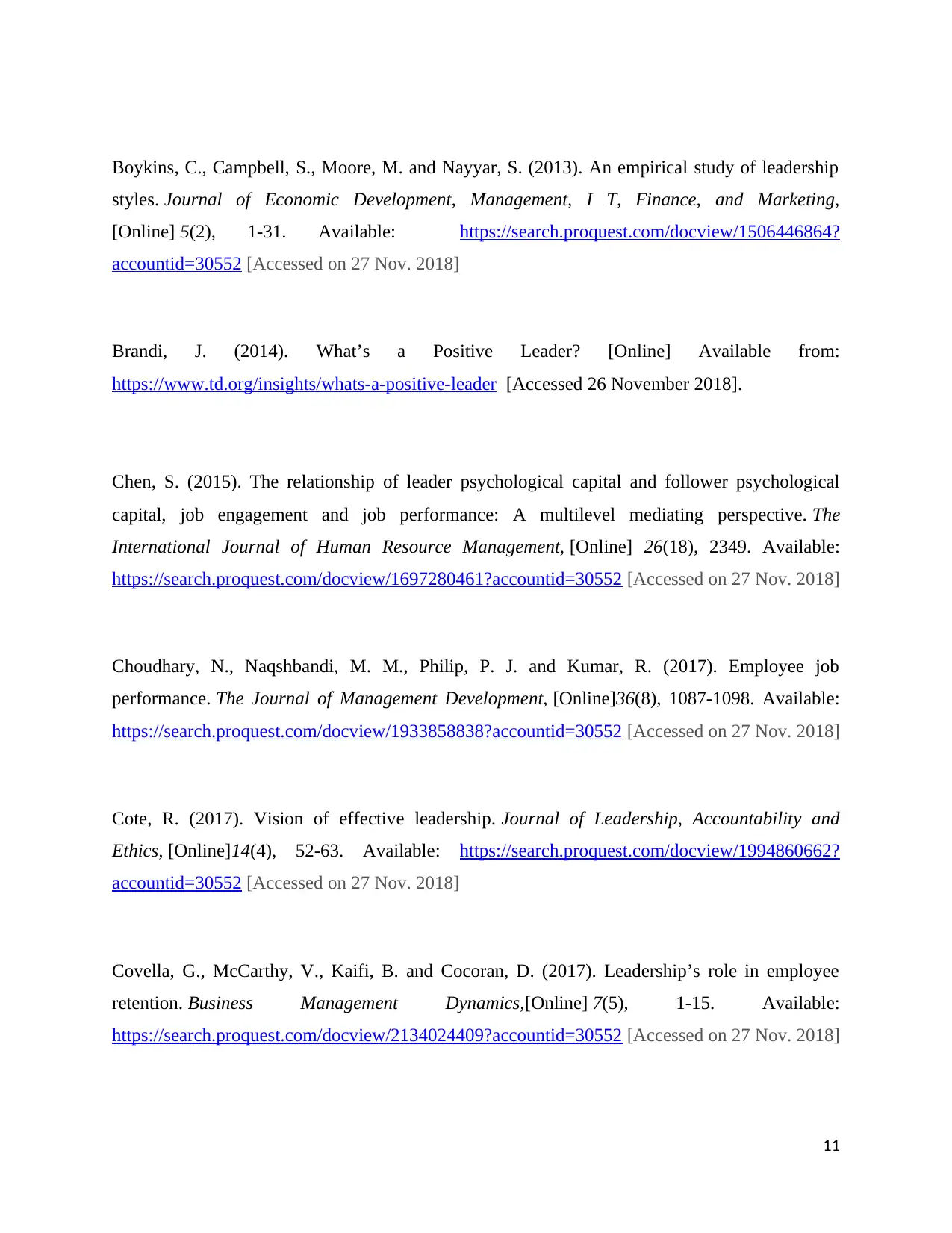
Boykins, C., Campbell, S., Moore, M. and Nayyar, S. (2013). An empirical study of leadership
styles. Journal of Economic Development, Management, I T, Finance, and Marketing,
[Online] 5(2), 1-31. Available: https://search.proquest.com/docview/1506446864?
accountid=30552 [Accessed on 27 Nov. 2018]
Brandi, J. (2014). What’s a Positive Leader? [Online] Available from:
https://www.td.org/insights/whats-a-positive-leader [Accessed 26 November 2018].
Chen, S. (2015). The relationship of leader psychological capital and follower psychological
capital, job engagement and job performance: A multilevel mediating perspective. The
International Journal of Human Resource Management, [Online] 26(18), 2349. Available:
https://search.proquest.com/docview/1697280461?accountid=30552 [Accessed on 27 Nov. 2018]
Choudhary, N., Naqshbandi, M. M., Philip, P. J. and Kumar, R. (2017). Employee job
performance. The Journal of Management Development, [Online]36(8), 1087-1098. Available:
https://search.proquest.com/docview/1933858838?accountid=30552 [Accessed on 27 Nov. 2018]
Cote, R. (2017). Vision of effective leadership. Journal of Leadership, Accountability and
Ethics, [Online]14(4), 52-63. Available: https://search.proquest.com/docview/1994860662?
accountid=30552 [Accessed on 27 Nov. 2018]
Covella, G., McCarthy, V., Kaifi, B. and Cocoran, D. (2017). Leadership’s role in employee
retention. Business Management Dynamics,[Online] 7(5), 1-15. Available:
https://search.proquest.com/docview/2134024409?accountid=30552 [Accessed on 27 Nov. 2018]
11
styles. Journal of Economic Development, Management, I T, Finance, and Marketing,
[Online] 5(2), 1-31. Available: https://search.proquest.com/docview/1506446864?
accountid=30552 [Accessed on 27 Nov. 2018]
Brandi, J. (2014). What’s a Positive Leader? [Online] Available from:
https://www.td.org/insights/whats-a-positive-leader [Accessed 26 November 2018].
Chen, S. (2015). The relationship of leader psychological capital and follower psychological
capital, job engagement and job performance: A multilevel mediating perspective. The
International Journal of Human Resource Management, [Online] 26(18), 2349. Available:
https://search.proquest.com/docview/1697280461?accountid=30552 [Accessed on 27 Nov. 2018]
Choudhary, N., Naqshbandi, M. M., Philip, P. J. and Kumar, R. (2017). Employee job
performance. The Journal of Management Development, [Online]36(8), 1087-1098. Available:
https://search.proquest.com/docview/1933858838?accountid=30552 [Accessed on 27 Nov. 2018]
Cote, R. (2017). Vision of effective leadership. Journal of Leadership, Accountability and
Ethics, [Online]14(4), 52-63. Available: https://search.proquest.com/docview/1994860662?
accountid=30552 [Accessed on 27 Nov. 2018]
Covella, G., McCarthy, V., Kaifi, B. and Cocoran, D. (2017). Leadership’s role in employee
retention. Business Management Dynamics,[Online] 7(5), 1-15. Available:
https://search.proquest.com/docview/2134024409?accountid=30552 [Accessed on 27 Nov. 2018]
11
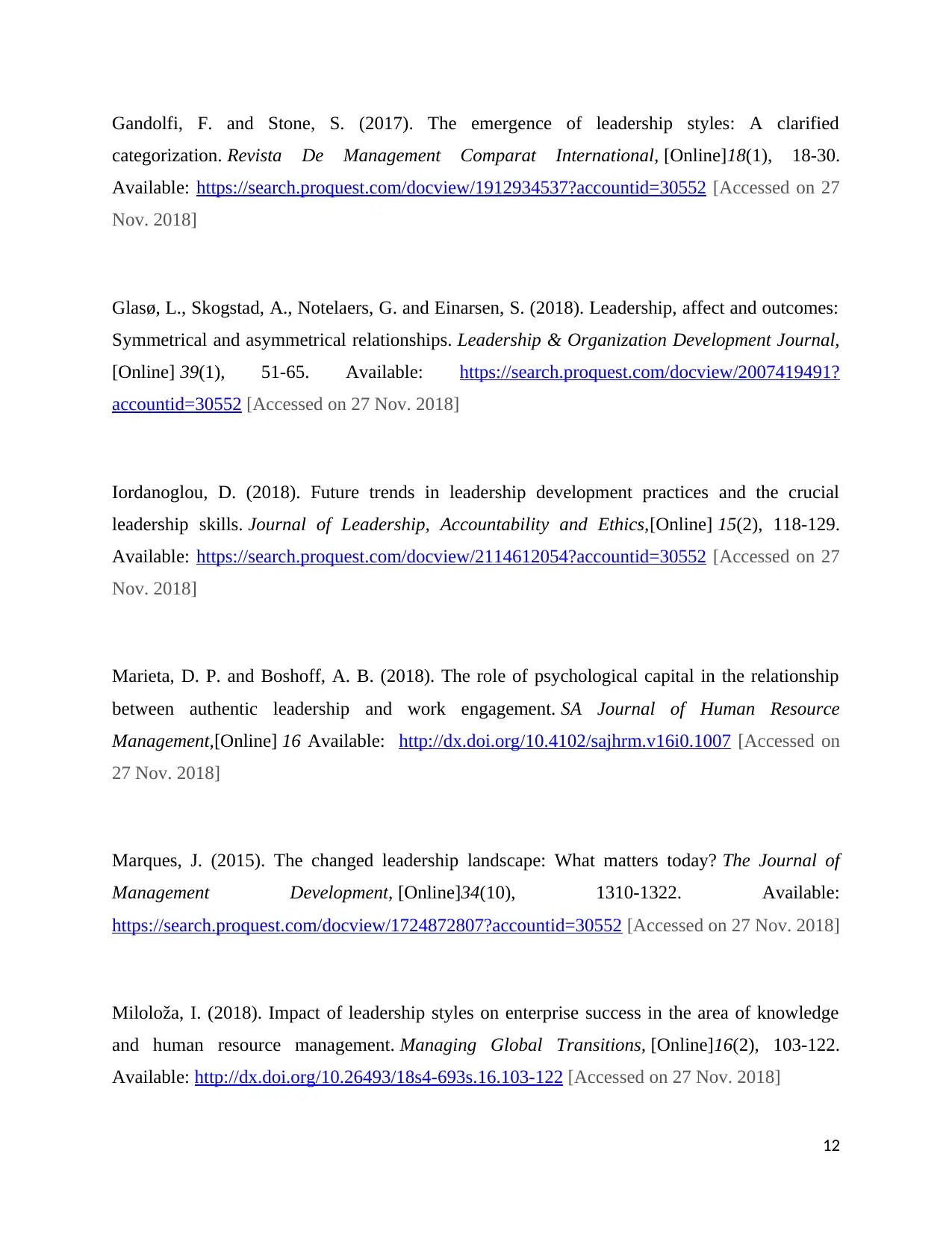
Gandolfi, F. and Stone, S. (2017). The emergence of leadership styles: A clarified
categorization. Revista De Management Comparat International, [Online]18(1), 18-30.
Available: https://search.proquest.com/docview/1912934537?accountid=30552 [Accessed on 27
Nov. 2018]
Glasø, L., Skogstad, A., Notelaers, G. and Einarsen, S. (2018). Leadership, affect and outcomes:
Symmetrical and asymmetrical relationships. Leadership & Organization Development Journal,
[Online] 39(1), 51-65. Available: https://search.proquest.com/docview/2007419491?
accountid=30552 [Accessed on 27 Nov. 2018]
Iordanoglou, D. (2018). Future trends in leadership development practices and the crucial
leadership skills. Journal of Leadership, Accountability and Ethics,[Online] 15(2), 118-129.
Available: https://search.proquest.com/docview/2114612054?accountid=30552 [Accessed on 27
Nov. 2018]
Marieta, D. P. and Boshoff, A. B. (2018). The role of psychological capital in the relationship
between authentic leadership and work engagement. SA Journal of Human Resource
Management,[Online] 16 Available: http://dx.doi.org/10.4102/sajhrm.v16i0.1007 [Accessed on
27 Nov. 2018]
Marques, J. (2015). The changed leadership landscape: What matters today? The Journal of
Management Development, [Online]34(10), 1310-1322. Available:
https://search.proquest.com/docview/1724872807?accountid=30552 [Accessed on 27 Nov. 2018]
Miloloža, I. (2018). Impact of leadership styles on enterprise success in the area of knowledge
and human resource management. Managing Global Transitions, [Online]16(2), 103-122.
Available: http://dx.doi.org/10.26493/18s4-693s.16.103-122 [Accessed on 27 Nov. 2018]
12
categorization. Revista De Management Comparat International, [Online]18(1), 18-30.
Available: https://search.proquest.com/docview/1912934537?accountid=30552 [Accessed on 27
Nov. 2018]
Glasø, L., Skogstad, A., Notelaers, G. and Einarsen, S. (2018). Leadership, affect and outcomes:
Symmetrical and asymmetrical relationships. Leadership & Organization Development Journal,
[Online] 39(1), 51-65. Available: https://search.proquest.com/docview/2007419491?
accountid=30552 [Accessed on 27 Nov. 2018]
Iordanoglou, D. (2018). Future trends in leadership development practices and the crucial
leadership skills. Journal of Leadership, Accountability and Ethics,[Online] 15(2), 118-129.
Available: https://search.proquest.com/docview/2114612054?accountid=30552 [Accessed on 27
Nov. 2018]
Marieta, D. P. and Boshoff, A. B. (2018). The role of psychological capital in the relationship
between authentic leadership and work engagement. SA Journal of Human Resource
Management,[Online] 16 Available: http://dx.doi.org/10.4102/sajhrm.v16i0.1007 [Accessed on
27 Nov. 2018]
Marques, J. (2015). The changed leadership landscape: What matters today? The Journal of
Management Development, [Online]34(10), 1310-1322. Available:
https://search.proquest.com/docview/1724872807?accountid=30552 [Accessed on 27 Nov. 2018]
Miloloža, I. (2018). Impact of leadership styles on enterprise success in the area of knowledge
and human resource management. Managing Global Transitions, [Online]16(2), 103-122.
Available: http://dx.doi.org/10.26493/18s4-693s.16.103-122 [Accessed on 27 Nov. 2018]
12
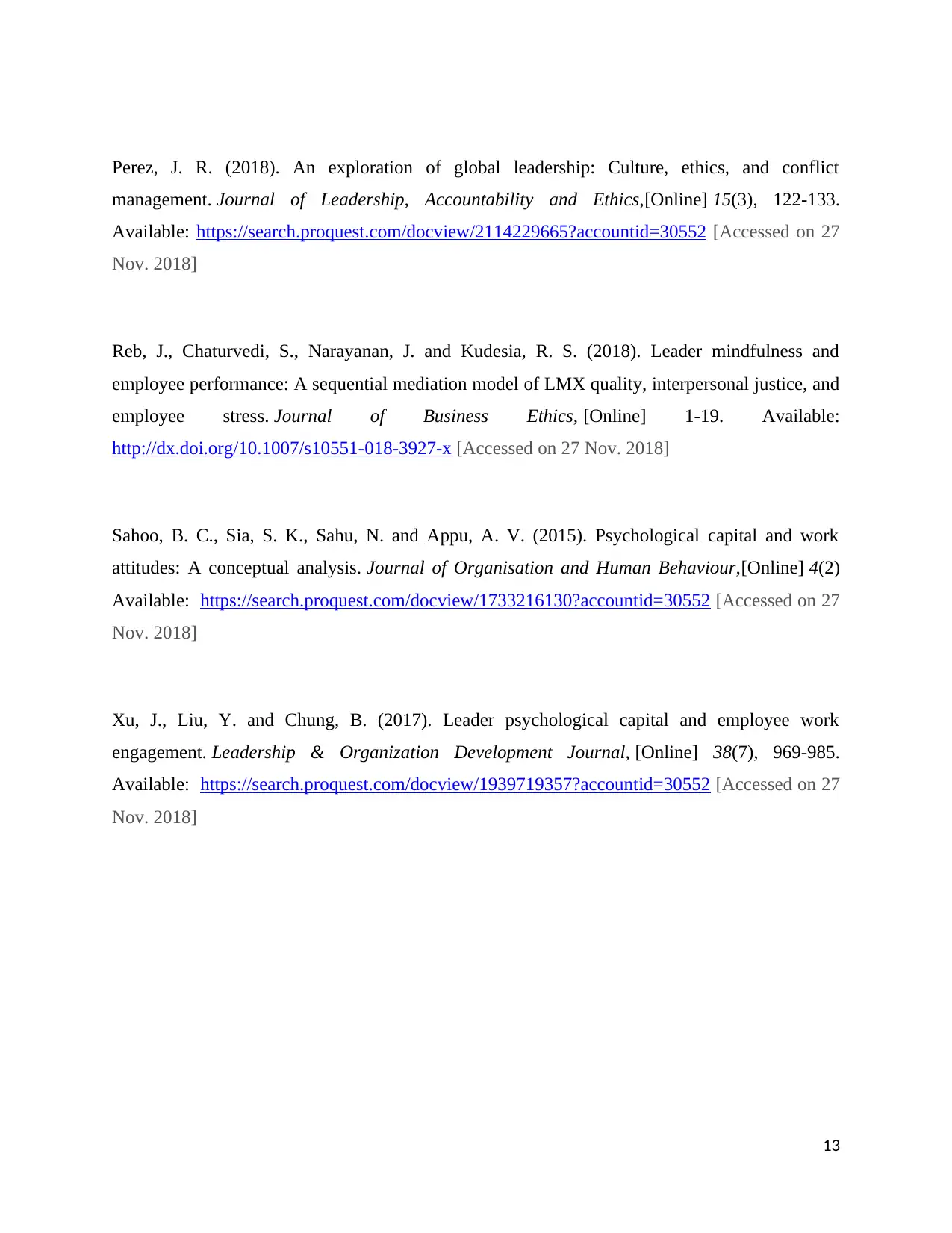
Perez, J. R. (2018). An exploration of global leadership: Culture, ethics, and conflict
management. Journal of Leadership, Accountability and Ethics,[Online] 15(3), 122-133.
Available: https://search.proquest.com/docview/2114229665?accountid=30552 [Accessed on 27
Nov. 2018]
Reb, J., Chaturvedi, S., Narayanan, J. and Kudesia, R. S. (2018). Leader mindfulness and
employee performance: A sequential mediation model of LMX quality, interpersonal justice, and
employee stress. Journal of Business Ethics, [Online] 1-19. Available:
http://dx.doi.org/10.1007/s10551-018-3927-x [Accessed on 27 Nov. 2018]
Sahoo, B. C., Sia, S. K., Sahu, N. and Appu, A. V. (2015). Psychological capital and work
attitudes: A conceptual analysis. Journal of Organisation and Human Behaviour,[Online] 4(2)
Available: https://search.proquest.com/docview/1733216130?accountid=30552 [Accessed on 27
Nov. 2018]
Xu, J., Liu, Y. and Chung, B. (2017). Leader psychological capital and employee work
engagement. Leadership & Organization Development Journal, [Online] 38(7), 969-985.
Available: https://search.proquest.com/docview/1939719357?accountid=30552 [Accessed on 27
Nov. 2018]
13
management. Journal of Leadership, Accountability and Ethics,[Online] 15(3), 122-133.
Available: https://search.proquest.com/docview/2114229665?accountid=30552 [Accessed on 27
Nov. 2018]
Reb, J., Chaturvedi, S., Narayanan, J. and Kudesia, R. S. (2018). Leader mindfulness and
employee performance: A sequential mediation model of LMX quality, interpersonal justice, and
employee stress. Journal of Business Ethics, [Online] 1-19. Available:
http://dx.doi.org/10.1007/s10551-018-3927-x [Accessed on 27 Nov. 2018]
Sahoo, B. C., Sia, S. K., Sahu, N. and Appu, A. V. (2015). Psychological capital and work
attitudes: A conceptual analysis. Journal of Organisation and Human Behaviour,[Online] 4(2)
Available: https://search.proquest.com/docview/1733216130?accountid=30552 [Accessed on 27
Nov. 2018]
Xu, J., Liu, Y. and Chung, B. (2017). Leader psychological capital and employee work
engagement. Leadership & Organization Development Journal, [Online] 38(7), 969-985.
Available: https://search.proquest.com/docview/1939719357?accountid=30552 [Accessed on 27
Nov. 2018]
13
1 out of 13
Related Documents
Your All-in-One AI-Powered Toolkit for Academic Success.
+13062052269
info@desklib.com
Available 24*7 on WhatsApp / Email
![[object Object]](/_next/static/media/star-bottom.7253800d.svg)
Unlock your academic potential
© 2024 | Zucol Services PVT LTD | All rights reserved.




